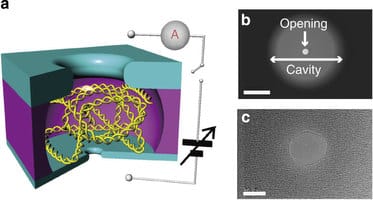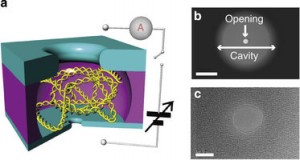Nanopore Cage Allows for Experiments in Single DNA Molecule

Researchers from Brown University have created the first cage that can hold a single DNA molecule. The finding, published this month in Nature Communications, will allow performing single-molecule experiments in a physically defined space of 6.2 femtoliters helping avoid diffusion-related problems of biopolymers in solution that make it difficult to study the same molecule for a long time.
The researchers injected a DNA molecule through the nanopore electrophoretically. Through a wider opening in the opposite side of the nanopore, other molecules could be introduced in the cage. The DNA, however, can’t escape through the wider pore as it adopts a globular structure. The researchers introduced a restriction enzyme and checked the effect on the DNA after pulling it out through the nanopore. As expected, they found it was cut in four pieces. It is the first time that the same molecule is checked before and after a biochemical experiment.
 The DNA cage can be considered as a one-molecule test tube where multiple experiments can be carried out. Hybridization probes could be applied using the same principle, and the effect on the same DNA molecule after the probing could be checked.
The DNA cage can be considered as a one-molecule test tube where multiple experiments can be carried out. Hybridization probes could be applied using the same principle, and the effect on the same DNA molecule after the probing could be checked.
Source: http://www.nature.com/ncomms/2015/150204/ncomms7222/full/ncomms7222.html
